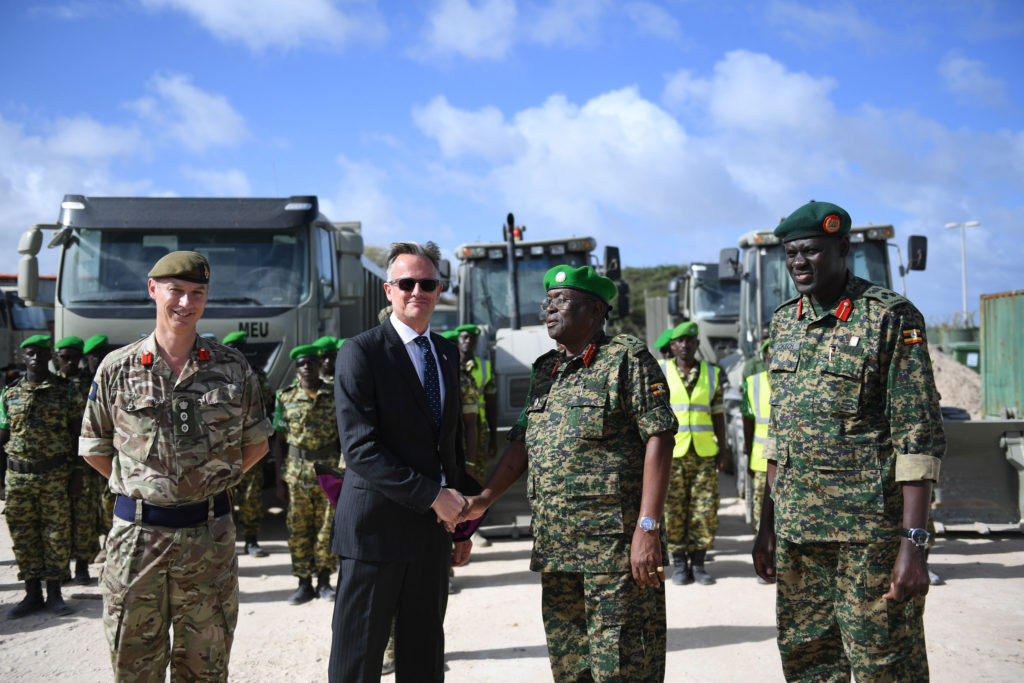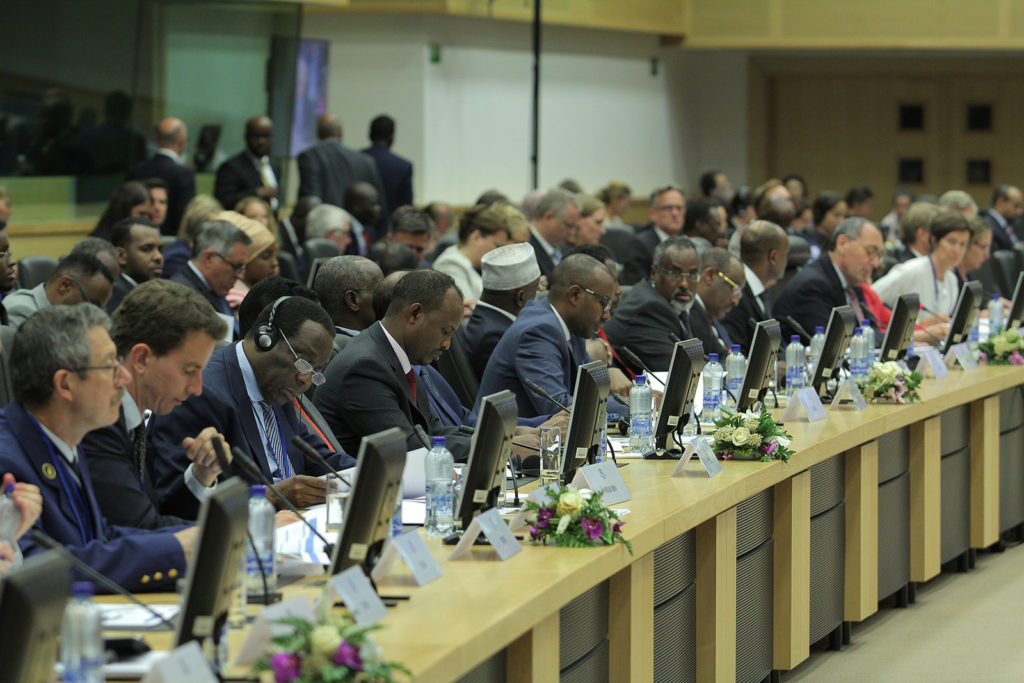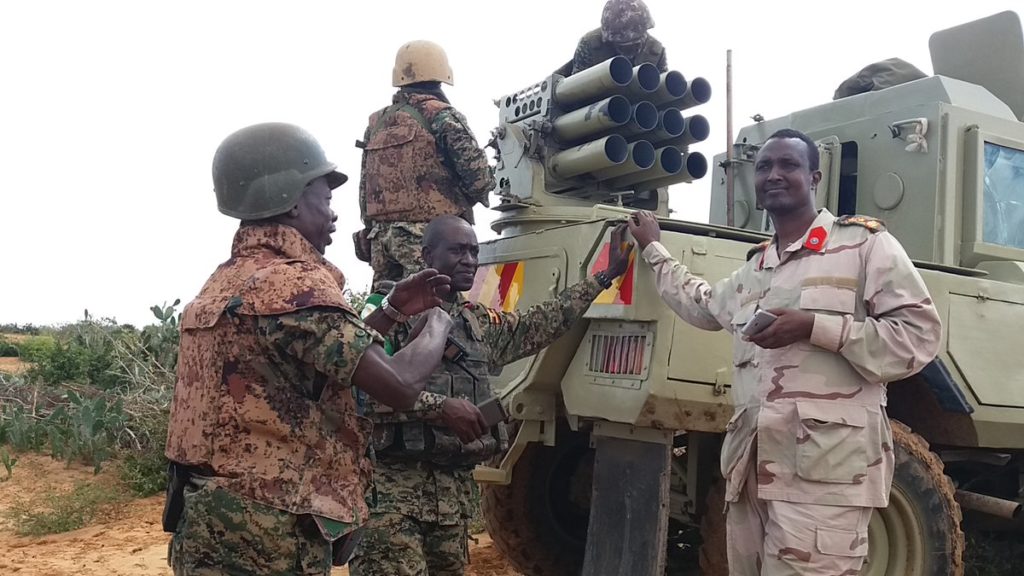AMISOM model too complicated to replicate in other theatres-expert

Debate on AMISOM’s withdrawal has been ongoing with the AU and the UN Security Council at odds on the timelines in the backdrop of unpredictable funding and slow progress in the Somali Security Sector. Goobjoog News editor T. Roble caught up with Prof. Paul Williams a don at George Washington University in the US at the sidelines of the just concluded Mogadishu Book Fair for his take on these issues. His new book, Fighting for Peace in Somalia: A History and Analysis of the African Union Mission (AMISOM), 2007-2017 takes a comprehensive assessment of a decade of AMISOM operations in Somalia.
Q: Based on your experience and in your recent book, do you think AMISOM can be a peace keeping model which can be replicated in Africa and even other world theatres?
A: I would say it’s a very complicated model and so I think it will be very difficult to replicate it in other parts of the world. And even if you could, I don’t think we should because I think it gets too complicated to easily work. So we should just clarify what the model is. The AMISOM model is, I mean it is African countries provide the troops and the police and the civilians for the peacekeeping mission, but because the African Union can’t pay and provide all the mission support and logistics, it means other partners have to come in. So the AMISOM model is African personnel and then in this case the European Union paying the allowances and some of the other sort of indirect costs for the mission and then the United Nations providing logistics support.
So if you think of that as the AMISOM model; African personnel, EU financing, UN logistics, and then let’s say mainly American training and equipping that is very difficult to replicate in other countries.
And that’s coming now through UNSOS, the UN Support Office in Somalia and they’re paying probably nearly 500, well over $500 million dollars a year for the logistics support to AMISOM. The EU I should have said, is paying about 300 million euros a year to support AMISOM peacekeepers. And then the fourth bit of the model is the training and equipping provided by bilateral partners, so mainly the United States and the United Kingdom, which is providing training and equipment and assistance for the troop contributing countries.
So if you think of that as the AMISOM model, African personnel, EU financing, UN logistics, and then let’s say mainly American training and equipping that is very difficult to replicate in other countries. If African Union wanted to do a mission, you know, let’s say the multinational task force against Boko Haram, could you get the EU to pay allowances again, the Americans to train and equip the UN to provide logistics?
No. Is the short answer. So that leads me to conclude that even if you thought the AMISOM model was a good idea, it’s going to be very, very difficult to bring all those four groups together again in any other theater. My own normative views sort of thing is that I think this is too complicated a model to replicate. So my argument would be that ideally if you want to do a peace operation, it should be done by one organization that is coherent and that kind of finances and provides the logistics and support.
Q. So it’s basically a much fractured relationship?
It’s actually very fractured as it means for AMISOM to work effectively the EU has got to be all on and agreeing and supporting the United Nations. And then bilateral partners like say Americans, the Brits, they’ve all got to agree. That’s a lot of people to agree and they don’t all agree on the priority of focusing on Somalia.
So for example, even within the European Union, the British have been focused a lot more on Somalia. They’ve argued you should continue to support AMISOM, but France has made a different argument. France has said it’s more concerned about the Sahel; it wants to spend more European Union money supporting the Sahel operations because that’s where French troops are operating.
So in the EU there has been a fight over how it should allocate resources in Africa and I think that just means that then AMISOM is susceptible to these donor arguments. AMISOM hasn’t got sustainable finances, finances behind it, and that’s not a good way to run a peace operation. And you know, now that the EU cut its allowances funding to AMISOM back in January 2016. So it means now we’ve got AMISOM peacekeepers being paid a lot less than they should be paid and that’s not good for morale. It’s not good for mission effectiveness.
A: Given these scenarios, are we seeing a situation where AMISOM might gradually be worn down and ultimately become a failed project?
There’s a theory of exit strategy, right? How the peace operation should lead and then there’s the practice and what’s happening in reality. So with AMISOM, the theory should be AMISOM should stay in Somalia until one of two things happen. I’m assuming they would stay here until there’s a peace settlement that ends the war and that they stay long enough to implement whatever that peace deal is. And secondly, AMISOM has got to stay long enough for the Somali security forces to be able to take care of Somalia security needs on their own.
At the moment, neither of those two things are happening. There’s no deal with Al Shabaab. There’s no end to the war, so AMISOM has got to stay for those reasons and if you look at the Somali security forces, the Somali National Army is in no fit state to deal with these challenges.
Then you’ve got the regional forces, the Somali Police Force trying to stand up; so the theory would say AMISOM should stay for probably quite a lot longer, right? Until we have a negotiated settlement with Al Shabaab or you see a Somali National Army that could really work on its own but the practice or where the reality might come in here is the money in particular. Now you can only run a peace operation if there’s the finances to sustain it. And as we just said, the European Union has dropped its funding and the African Union must find another donor to come in and replace that. As a result, AMISOM’s peacekeepers have had their funding cut by 20 percent in terms of their allowances.

Maybe Burundi, Uganda, Ethiopia, Kenya, and Djibouti are not going to be happy to stay here if they’re not getting paid what they agreed to be paid. It should be about a thousand and 28 US dollars per peacekeeper and they’re now getting about $800. At the moment, all the countries have stayed and they’ve said, okay, we’ve taken that 20 percent cut but we’re still going to stay, but what if it dropped down to 30 percent next year when Britain, for example, might leave the European Union in 2019. What if Trump’s administration in America and Nikki Haley, the US ambassador to the UN, they are trying to cut the UN’s peacekeeping budget? They’ve asked to cut it by like $500 million Dollars. If they did, that would cut the UNSOS funding for the logistic support to AMISOM.
So there’s the theory of exit and then there’s these things that might happen and I think financing is the main one at the moment.
And then the other thing on the practice you can never know in advance and predict the future. So say we’ve seen a number of attacks on AMISOM’s bases where Al Shabaab has killed AMISOM troops. They’ve stolen lots of equipment now so far, no, AMISOM TCC has run away because of that, but who knows in the future, right? If Al Shabaab is successful here, there may be some event that causes a withdrawal.
Q: The African Union through Amisom has warned the draw-down decision was informed by inaccurate assessment. Does this suggest Amisom has become a baggage to the Security Council and that the draw-down is motivated by the need to rid it given competing priorities and interests at the Council?
All peace operations have to leave at some point, right? They are not permanent occupying forces. There has to be an exit strategy for a peace operation.
But in AMISOM’s case, I think AMISOM can only leave Somalia or should only leave Somalia when Somali political leaders have come together, they’ve reconciled. And so I mean here, the federal government and the regional administrations reconcile their differences. They agree on the new constitution for the country. And crucially for us here, they agree on the national security architecture.
Now we’ve got the paper that came out here in April 2017 and the London Security Pact. Somali leaders on paper, now have a National Security Architecture, but it’s not implemented, it’s not real yet. So they’ve actually got to come together and really implement this new national security framework. That would enable AMISOM to draw down again a bit, like I said, because if the Somalia national security can actually be implemented and you have a better national army, AMISOM could start withdrawing more numbers, but AMISOM shouldn’t leave anytime soon.
Now the AMISOM people who you mentioned, they said they didn’t see the Somali army growing effectively, so they thought it was a bad idea to draw AMISOM’s numbers. I think why the Security Council decided to cut a thousand troops was, well, I think reasonably losing a thousand troops out of 22,000 is not a strategic game changer, right? It doesn’t mean that AMISOM stops being effective, but it sends a political signal to the Somali government that AMISOM is not going to be around forever, so you need to get your act together.

You need to make decisions about your national security architecture in your army quickly. AMISOM has been here 10 or 11 years now already. Why haven’t Somalia’s politicians agreed on a national constitution? Why haven’t they agreed on a national security framework and architecture? And why haven’t the regional administrations and the government agreed on how to implement it and agreed on how to finance it and agreed what are the tasks that the Somali army should be doing? That’s why I think AMISOM got nervous, but that’s why I think the Security Council is using the withdrawal as a political message or political signal to the Somali government. This is where, again, the money comes in. If the money to AMISOM is not going to be 100 percent, we’ve got to guard against the fact that there might be premature withdrawals. I think for me, that’s what this debate about withdrawal is about. It’s a sort of political game of leverage.
A: You address the issue of strategic communications by both Al-Shabaab and AMISOM in your new book. Especially in light of casualty reporting, could you shed some light on AMISOM’s strategic communications and its effectiveness?
I would say I disagree with AMISOM’s policy on this. I think they made the wrong decision, it’s a very controversial issue. AMISOM’s official policy, or I should say the African Union’s official policy is that the African Union is not going to release AMISOM’s casualty figures. They don’t do that. They said that’s a decision for the TCC governments to make. None of the TCC governments have released their full list of casualty figures. They’ve occasionally released some for particular incidents, but none of the TCCs have put out like a full list. I disagree with that in policy for a couple of reasons.
I disagree that if we send peacekeepers into Somalia, when they die on the mission, I think it’s morally unacceptable not to publicly recognize that person’s contribution
One is a moral argument. I think morally, if we’d send peacekeepers to any country, not just Somalia, I think we are asking them to take serious risks and put their lives on the line and I think if we deploy them and send them to these countries to promote peace and stability, if they are killed on that mission, we should publicly recognize their sacrifice. And so I agree with the United Nations policy on this. In every UN peacekeeping mission, if a UN peacekeeper is killed, they are publicly recognized, their family is publicly supported and they’ve given them the compensation payments. So morally, I disagree that if we send peacekeepers into Somalia, when they die on the mission, I think it’s morally unacceptable not to publicly recognize that person’s contribution. I don’t think keeping it secret, um, is really morally justified.

But then on the operational security side, there’s a second part to this argument which gets to the strategic communications. Now AMISOM and the TCCs say they don’t want to release these casualty figures for operational reasons, right? They think it will enhance Shabaab’s propaganda and it will undermine the morale of AMISOM’s soldiers. I disagree on both of those things. I think if you don’t release the fatalities figures, that undermines AMISOM’s morale. I think for the soldiers deployed out into a forward operating base their morale will be stronger and better if they know that if they’re killed on this mission, they will be publicly recognized and their family will receive the compensation. I think it undermines their morale if they think, if I’m killed, who’s going to know what’s going to happen? I think here, if AMISOM doesn’t give the truthful number of casualties in any of these battles that agives the upper hand to Al Shabaab.
If AMISOM doesn’t put accurate figures out there, it leaves a space in the media for somebody else to fill and what we’ve seen for years now, these other people fill that space and they’re not necessarily telling the truth. So Al Shabaab gives all these numbers, which I don’t believe Al Shabaab figures. So I think if you don’t put some authentic, truthful number out there, you are ceding ground to your opposition. And what I think this does, the way I would conceptualize this, AMISOM’s policy creates strategic uncertainty about these issues.
And I think that strategic uncertainty plays into the hands of Al Shabaab. They come out with their photos and videos and here’s all the equipment we stole, here’s the dead bodies.
I think strategic communications is all about being an authentic, credible voice.
Q: Given the TCCs operate in a near autonomous way with a weak central command, does this contribute to what is playing out in terms of its strategic communications?
A: AMISOM sectors are run by different national TCCs. So in the sectors, AMISOM force headquarters has not had real operational control over what their KDF (Kenya Defence Forces) are doing, in sector two and six and what the ENDF (Ethiopia National Defence Forces) are doing in sector three. Now, the reason for that is partly because of the mandate and the context of Somalia. And by that I mean AMISOM has an enforcement warfighting or counterinsurgency mandate and the closer you get to warfighting, the more unilateral you want your operations to be. It’s very hard to fight a war if you’ve got lots of different countries, soldiers involved, so it’s sensible if you’re trying to fight a war to actually say, look, the Kenyan military knows the Kenyan military best, let the Kenyan military cover this area and then let the Ethiopian military cover that area.

If your job is not traditional peacekeeping, but like counterinsurgency and warfighting, it means as a result of that, if you adopt that approach, it means that the force headquarters can’t really control or know what’s happening in the sectors and it means you get not very coordinated and not very coherent operation. It’s no surprise that Shabaab locates in the borders between them because AMISOM struggles to do cross sector operations and multinational operations.
We need to have coherent operations across the sectors, and you may remember back in February of 2016, there was a thing called the Djibouti declaration that AMISOM’s TCCs wrote and that had an extraordinary line that asked and sort of reiterated to AMISOM’s TCCs that they’ve got to follow the orders of the force commander. The fact that you have to write that in a declaration saying you need to obey the force commander tells you people weren’t obeying! As part of the reason why AMISOM struggles to be coherent in terms of getting the information out is because the African Union in Addis Abba can’t just dictate to the Kenyan government or the Ugandan government or the Ethiopian government what to do.